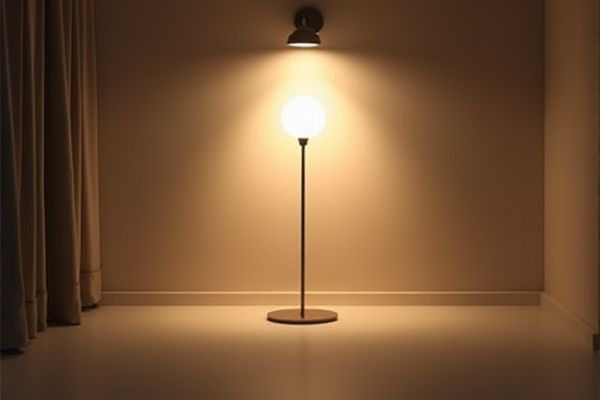
Clip-on lights offer flexibility by easily attaching to surfaces for focused illumination without occupying space, while freestanding lights provide stable, versatile lighting options that can be moved and adjusted freely. Explore the detailed comparison below to determine which lighting option best suits your needs and enhances your workspace.
Table of Comparison
| Feature | Clip-On Light | Freestanding Light |
|---|---|---|
| Portability | Highly portable, easy to attach/detach | Less portable, typically heavier |
| Placement | Clips onto surfaces like desks or shelves | Stands independently on floors or tables |
| Space Efficiency | Compact, saves space | Requires dedicated floor or table space |
| Light Coverage | Focused, ideal for task lighting | Wider light distribution, ambient lighting |
| Power Source | Usually USB or battery-powered | AC powered, sometimes battery options |
| Adjustability | Flexible neck or swivel clip | Adjustable height and angle in many models |
| Use Cases | Reading, crafting, computer work | Room lighting, decoration, reading |
| Price Range | Generally lower cost | Varies from moderate to high cost |
Introduction to Clip-On and Freestanding Lights
Clip-on lights offer versatile, space-saving illumination by attaching directly to desks, shelves, or headboards, making them ideal for focused tasks and small areas. Freestanding lights provide stable, adjustable lighting with a base that stands independently, perfect for larger spaces and ambient room lighting. Choosing between your clip-on and freestanding light depends on the specific lighting needs and available space in your environment.
Design and Portability Comparison
Clip-on lights feature a compact, lightweight design that attaches directly to surfaces, maximizing portability and saving desk space. Freestanding lights offer a stable base and often larger, more adjustable fixtures ideal for dedicated workstations. Your choice depends on whether you prioritize mobility and space efficiency or sturdiness and extended adjustability.
Installation and Setup Differences
Clip-on lights offer quick installation by easily attaching to surfaces such as desks, shelves, or headboards without tools or permanent fixtures. Freestanding lights require more space and may involve unplugging and positioning but need no mounting, making them portable and flexible for various room layouts. The clip-on design is ideal for targeted illumination with minimal setup, whereas freestanding lights provide broader lighting coverage with straightforward placement options.
Light Coverage and Adjustability
Clip-on lights offer focused light coverage ideal for small workspaces, allowing you to direct illumination precisely where needed with adjustable clamps and swivel heads. Freestanding lights provide broader light coverage, illuminating larger areas with flexible necks or adjustable arms for versatile positioning. Your choice depends on whether you prioritize targeted lighting in compact spaces or widespread brilliance for more expansive environments.
Power Sources and Energy Efficiency
Clip-on lights typically rely on USB or battery power, making them highly portable and energy-efficient for small, focused tasks. Freestanding lights often connect to AC power, offering higher brightness but potentially consuming more electricity over extended use. Choosing between the two depends on balancing mobility and sustained energy efficiency needs.
Applications and Ideal Use Cases
Clip-on lights are ideal for task-specific applications such as reading, crafting, or computer work where focused illumination is needed without occupying desk space. Freestanding lights suit broader ambient lighting needs in living rooms, offices, or bedrooms, offering adjustable brightness and easy repositioning. Both types optimize lighting efficiency but cater to different spatial and functional requirements based on user preferences.
Space-Saving Benefits
Clip-on lights offer significant space-saving benefits by attaching directly to surfaces like desks or shelves, eliminating the need for additional floor or table space. Freestanding lights require dedicated floor or table area, making them less ideal for compact or cluttered environments. Choosing a clip-on light can optimize Your workspace by freeing up valuable surface areas.
Durability and Maintenance
Clip-on lights typically feature compact, lightweight designs with durable metal or plastic clamps that resist wear but may experience hinge loosening over time, requiring occasional tightening or replacement. Freestanding lights offer robust, stable bases and often use higher-quality materials such as steel or heavy-duty plastic, enhancing their longevity and minimizing frequent maintenance. Maintenance for clip-on lights mainly involves cleaning the clamp and checking the electrical connections, whereas freestanding lights may need periodic base stabilization and bulb replacement for sustained durability.
Price Comparison and Value for Money
Clip-on lights generally cost less than freestanding lights, with prices typically ranging from $10 to $40 compared to $30 to $100 for freestanding models. Clip-on lights offer greater value for money in small spaces or temporary setups due to their portability and ease of installation. Freestanding lights, while more expensive, provide better stability and often feature adjustable brightness and height, adding to their long-term usability and investment value.
Choosing the Best Light for Your Needs
A clip-on light offers flexible positioning and is ideal for small spaces or focused tasks, while a freestanding light provides broader illumination and stylish presence in larger rooms. Consider your workspace size, lighting intensity preference, and portability requirements when choosing the best light for your needs. Your decision should balance functionality and design to enhance both comfort and productivity.
 homyna.com
homyna.com